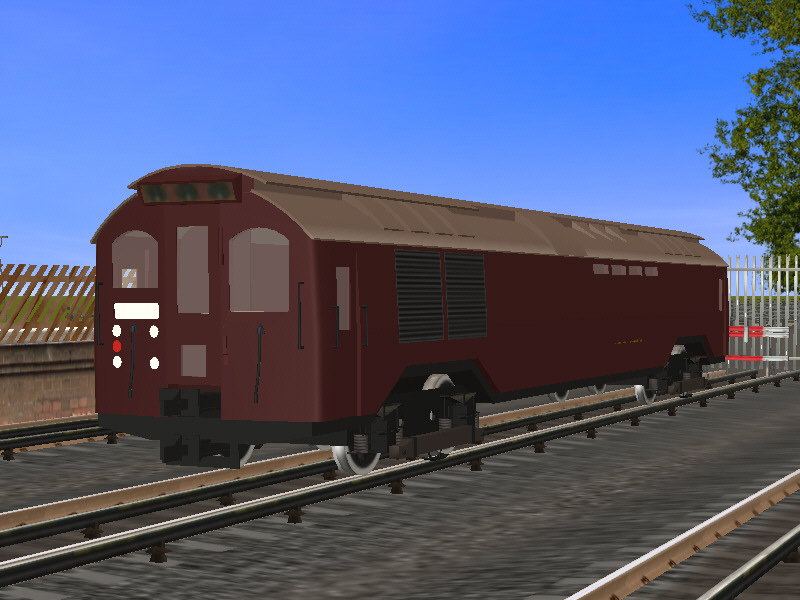
The engineering & service stock of the London Underground is mostly built to a smaller loading gauge (size) than normal railways, and has lower height couplings, so as to be able fit the deep level tunnels and couple to existing tube stock. Some stock is however built to the normal dimensions, cannot couple to tube stock without the use of match wagons and cannot be used in the tunnel sections.
In 1964 a new shunting locomotive for Acton Works was constructed, numbered L11. It was manufactured by cutting in half two standard 1931 tube stock DMs, car numbers 3080 and 3109, and joining the driving ends back to back. Most of the underframe equipment was moved into the body to facilitate servicing.The east (Acton works) end had ward couplings at both surface stock and tube stock height, and the latter could be fitted with an adaptor to enable it to connect to more modern stock fitted with the wedgelock type coupling. This end also had the communicating door replaced by a stable door arrangement and a lighting unit fitted so as to make it easier for the driver to see the coupler.
Initially the standard maroon livery was used, but in 1983 it was repainted in the new engineers' vehicle yellow livery. It was withdrawn from service in 1989, and was stored in the open initially at Ruislip, then later at Acton works. In 2004 a preservation group moved it to a compound outside the signal box at Epping, and did some restoration work, but it is now looking rather sorry for itself again.
One of my earlier models that has been extensively revamped. This
model was used as the basis of the standard stock model. The model is
complete externally, but the interior still requires work.

| Item |
KUID |
Status |
|---|---|---|
| Acton Shunter L11 (maroon livery) |
<KUID2:338848:60:1> |
In Progress / Alpha |
| Acton Shunter L11 (yellow livery) |
<KUID2:338848:61:1> |
In Progress / Alpha |
| Z-type Power Bogie |
<KUID2:338848:50006:1> |
Complete |
Pilot motors and Ballast motors have very similar function on the
London Underground. Pilot motor cars are used for piloting odd
vehicles (perhaps damaged) from one place to another, whereas Ballast
motors are used as motive power for ballast trains. They are used in
pairs, topping and tailing the vehicles being piloted, or the ballast
wagons.
In 1971 four Q38 motor cars 4416-4419 were selected for pilot motor
duty, and renumbered the next year as L126-L129. They retained their
red livery until 1974 (L126 & L127) and 1976(L128 & L129),
when they were repainted in the general service maroon livery. In 1983
L128 & L129 were withdrawn, but L126 & L127 were
repainted in engineers' vehicle yellow livery. These two have now been
repainted in red livery, their original numbers restored, and are
resident in the LT museum's Acton Depot.
| Item |
KUID |
Status |
|---|---|---|
| Ex Q38 Stock Pilot Motor Car
(red livery) |
<KUID2:338848:62:1> |
In Progress |
| Ex Q38 Stock Pilot Motor Car
(maroon livery) |
<KUID2:338848:63:1> |
In Progress |
| Ex Q38 Stock Pilot Motor Car
(yellow livery) |
<KUID2:338848:64:1> |
In Progress |
| O Stock Motor Bogie | <KUID2:338848:50004:1> | Complete |
| O Stock Trailing Bogie | <KUID2:338848:50005:1> | Complete |
| O Stock Enginespec | <KUID2:338848:51001:1> | Complete |
| CO/CP Stock Hornsound | <KUID2:338848:54000:1> | Published on TPR |
| Taillamp | <KUID2:338848:35002:1> | Complete |
Fourteen assorted standard stock DMs from Cammell Laird and Metro-Carriage were selected for Ballast motor duty in 1954 and given the new numbers L62-L75. Initially these were painted grey, but in 1957 they were repainted in maroon (supposedly to use up stocks of Metropolitan Railway maroon paint). In 1967 L72 was damaged, and rather than being repaired, it was replaced by another withdrawn standard stock car which was given the same number. In 1967 another car L73 was also damaged and replaced with another withdrawn unit, but this time the old number was not re-used, the 'new' car becoming L77. All these cars were withdrawn in 1977/1978 and scrapped.
In 1978 another eight cars were selected for pilot motor duty and
given the numbers L130-L137. Four of these cars were withdrawn in 1971
without even having been repainted, although one of these was
subsequently transfered to the Isle of Wight. The remaining four
received the enineers' vehicle yellow livery
in 1983. They were subsequently transfered to LU's heritage fleet, but
L130 & L135 were scrapped only last month, probably on account of
their poor condition after having been stored in the open for so long.
L131 & L134 have been cosmetically restored and are under cover in
the Acton Depot museum.
| Number |
Stock |
Old Number |
Converted |
Withdrawn |
| L62 |
1923 Cammell Laird |
3452 |
02/09/1954 |
1977 |
| L63 |
1923 Cammell Laird |
3463 |
15/071954 |
1977 |
| L64 |
1923 Metro-Carriage |
3500 |
07/03/1955 |
1977 |
| L65 |
1923 Cammell Laird |
3453 |
02/09/1954 |
1977 |
| L66 |
1923 Cammell Laird |
3476 |
18/03/1954 |
1977 |
| L67 |
1923 Metro-Carriage |
3501 |
19/01/1955 |
1977 |
| L68 |
1923 Metro-Carriage |
3494 |
12/10/1954 |
1977 |
| L69 |
1923 Metro-Carriage |
3505 |
21/09/1954 |
1977 |
| L70 |
1923 Metro-Carriage |
3496 |
15/06/1954 |
1977 |
| L71 |
1923 Metro-Carriage |
3507 |
08/04/1954 |
1977 |
| L72 |
1923 Metro-Carriage |
3498 |
21/09/1954 |
1963 |
| L72 |
1927 Metro-Carriage |
3376 |
1963 |
1977 |
| L73 |
1923 Metro-Carriage |
3513 |
18/05/1954 |
1967 |
| L74 |
1923 Metro-Carriage |
3506 |
18/05/1954 |
1977 |
| L75 |
1923 Metro-Carriage |
3517 |
28/10/1954 |
1977 |
| L77 |
1931 Metro-Cammell |
3183 |
1967 |
1977 |
| L130 |
1934 Metro-Cammell |
3690 |
1967 |
Scrapped Acton Works 2013 |
| L131 |
1934 Metro-Cammell |
3693 |
1967 |
On display in LT museum |
| L132 |
1927 Metro-Carriage |
3338 |
1967 |
1971 |
| L133 |
1934 Metro-Cammell |
3707 |
1967 |
1971 |
| L134 |
1927 Metro-Carriage |
3370 |
1967 |
On display in LT museum |
| L135 |
1934 Metro-Cammell |
3701 |
1967 |
Scrapped Acton Works 2013 |
| L136 |
1927 Metro-Carriage |
3380 |
1967 |
1971 |
| L137 |
1931 Metro-Cammell |
3273 |
1967 |
1971 transferred to IOW |
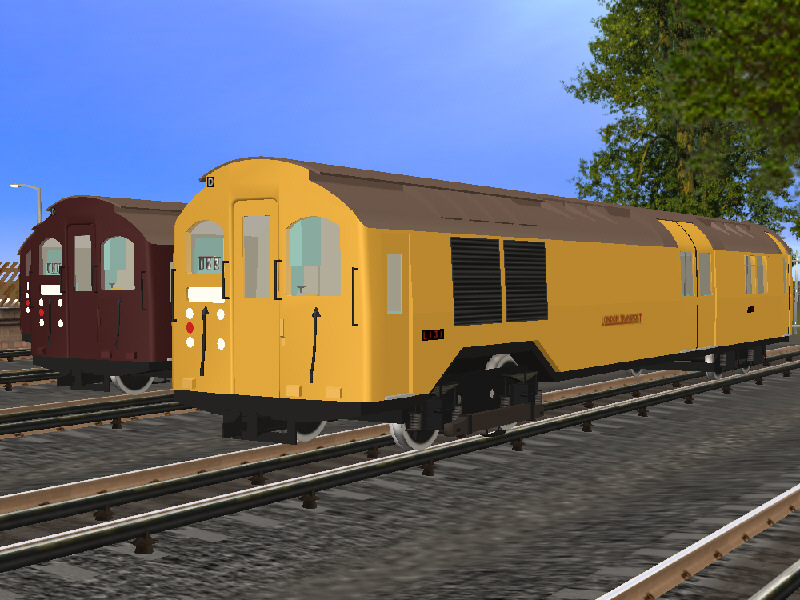
| Item |
KUID |
Status |
|---|---|---|
| Standard Stock Ballast Motor
(maroon livery) |
<KUID2:338848:65:1> |
In Progress / Alpha |
| Standard Stock Ballast Motor
(yellow livery) |
<KUID2:338848:66:1> |
In Progress / Alpha |
| Standard Stock Ballast Motor
(grey livery) |
<KUID2:338848:67:1> |
Planned |
| Z-type Power Bogie | <KUID2:338848:50006:1> | Complete |
| W2-type Trailing Bogie |
<KUID2:338848:50016:1> |
Complete |
To combat the problem of 'leaves on the line', London Underground operates a number of Rail Adhesion Trains. These can spray water on the track to remove leaves, and apply Sandite (a mixture of sand, aluminium and an adhesive). Two of these trains are based on withdrawn 1962 stock but are now in the 'corporate' red white and blue livery. Unlike normal passenger trains these cars do not have the doors painted red, indicating that they are not passenger carrying vehicles.
This model is basically complete, but has a problem with the script
which seems to be caused by a bug in Trainz itself, preventing it's
release.
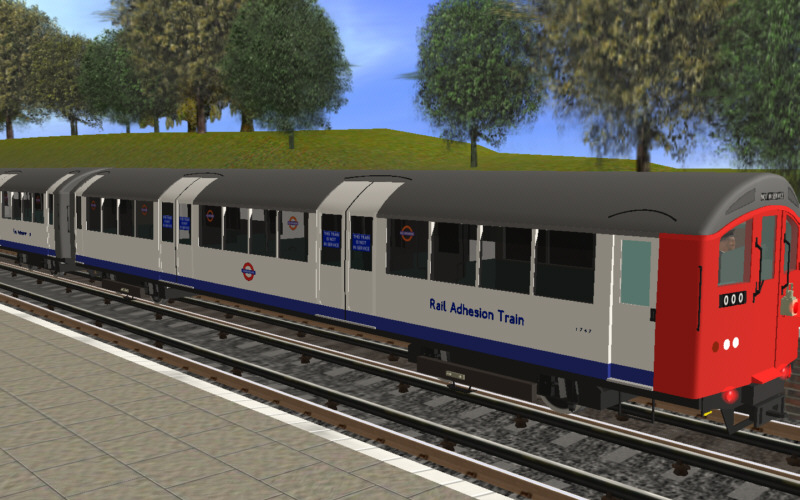
| Item |
KUID |
Status |
|---|---|---|
| 1962 Stock RAT DM |
<KUID2:338848:68:1> |
Beta |
| 1962 Stock RAT Trailer |
<KUID2:338848:69:1> |
Beta |
| 1962 Stock RAT NDM |
<KUID2:338848:73:1> |
Beta |
| 1956/1959 Stock Power Bogie |
<KUID2:338848:50020:1> |
Published on TPR |
| 1956/1959 Stock Trailing Bogie |
<KUID2:338848:50021:1> |
Published on TPR |
| 1956/1959 Stock Enginespec |
<KUID2:338848:51003:1> |
Published on TPR |
| 1956/1959 Stock Interior |
<KUID2:338848:55004:1> |
Published on TPR |
| CO/CP Stock Hornsound |
<KUID2:338848:54000:1> |
Published on TPR |
| LU Taillamp |
<KUID2:338848:35002:1> |
Published on TPR |
London Underground has used a large variety of steam locomotives over the years. The subsurface lines were originally designed for steam traction, which is why there are frequent openings in the roof on the Circle, Metropolitan and District lines to vent steam and smoke. Electric traction was only introduced in 1899, but by 1905 all passenger services south of Harrow were electric. Steam continued to be used for engineering and goods workings, until the withdrawal of the last of the ex-GWR pannier tanks in 1971.
The A class were the first locomotives built for the Metropolitan Railway after the GWR withdrew it's stock following a disagreement in 1863, and were a class of 44 locomotives built by Beyer Peacock between 1864 and 1869. The B class was a series of 22 similar locomotives, but with slightly shorter coupled wheelbase and larger bunkers also built by Beyer Peacock between 1879 and 1885. The District Railway also ordered 54 very similar locomotives between 1871 and 1886. Originally all these locomotives were fitted with condensing gear, and had a weather board rather than a cab to improve visibility. Following electrification in 1905, most of these locomotives were withdrawn, the Metropolitan retaining 13, and the District 6. Further withdrawals in the 1920s left only 5, for use on the Brill branch and engineering work. After closure of the branch in 1935, and the transfer of all workings north of Rickmansworth to the LNER in 1938, all were withdrawn except number 23, which was renumbered L45. This lasted until 1948, at which point it was withdrawn for preservation, and is currently in the LT museum.
With it's inclined cylinders, this loco represented a real
challenge, as the animation had to be done frame by frame, but it is
very satisfying to see it run. The model now has a number of
alternative components so that the different versions can be produced.
Still quite a bit to be done, but most of the basics are there.
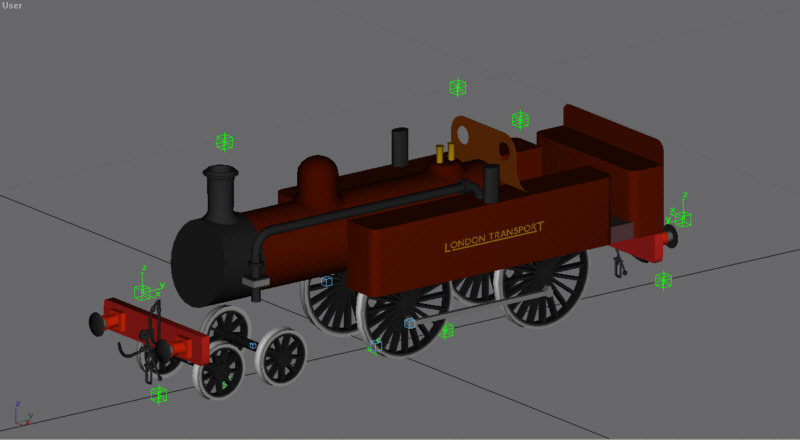
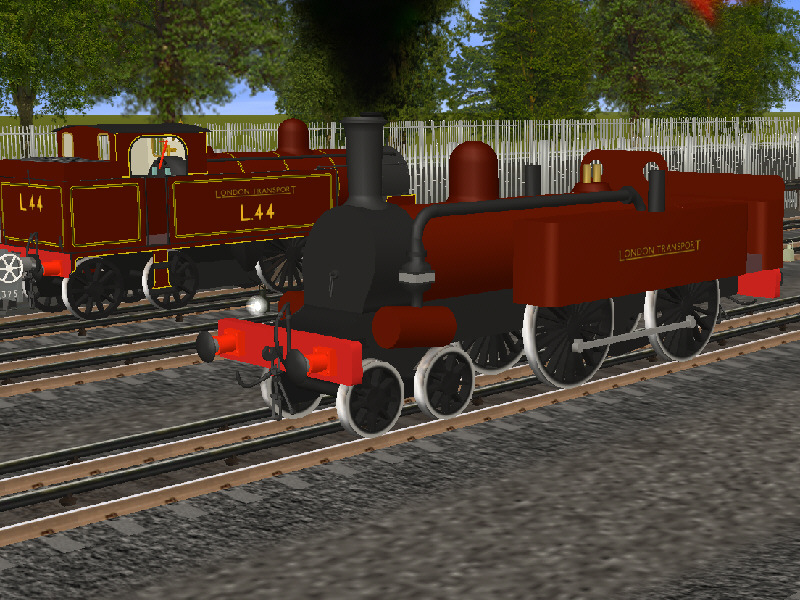
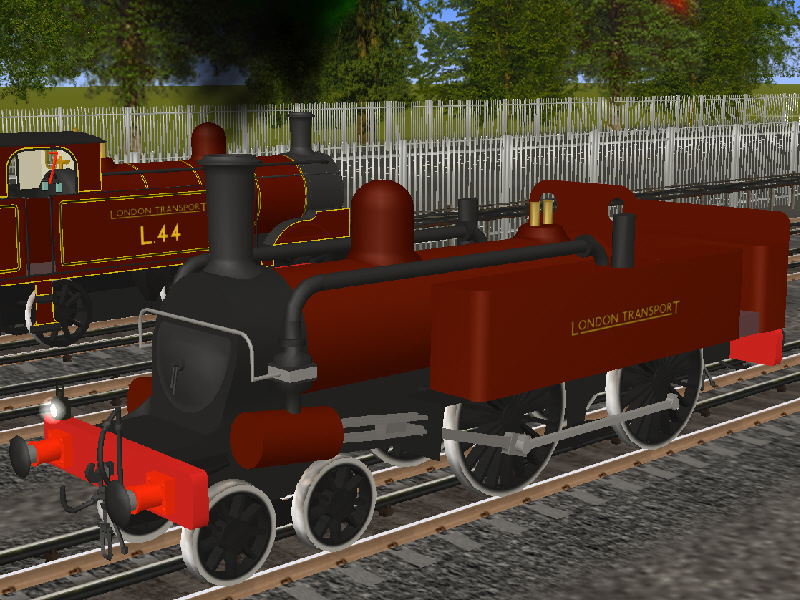

| Item |
KUID |
Status |
|---|---|---|
| Metropolitan A Class condensing loco in LU livery |
<KUID2:338848:220:1> |
In Progress / Alpha |
| Metropolitan A Class condensing loco in Met livery |
<KUID2:338848:221:1> |
In Progress / Alpha |
| Metropolitan A Class non-condensing loco in LU livery | <KUID2:338848:222:1> |
Planned |
| Metropolitan A Class non-condensing loco in Met livery | <KUID2:338848:223:1> |
Planned |
| Metropolitan A Class early condition, Met Livery |
<KUID2:338848:224:1> |
In Progress / Alpha |
| LU ex-Met A class front bogie |
<KUID2:338848:50037:1> |
Complete |
| LU ex-Met A class rear bogie |
<KUID2:338848:50038:1> |
Complete |
| Metropolitan A class front bogie |
<KUID2:338848:50039:1> |
In Progress |
| Metropolitan A Class rear bogie |
<KUID2:338848:50040:1> |
In Progress |
| Head lamp |
<KUID2:338848:35005:1> |
Published on TPR |
| Tail lamp |
<KUID2:338848:35002:1> |
Published on TPR |
The C class locomotives were four 0-4-4Ts built in 1891 by Neilson
& Co. to an South Eastern Railway Stirling design (SER Q Class).
They were numbered 67-70, and were sold or scrapped around 1920.
The D class locomotives were six 2-4-0Ts built in 1894/1895 by
Sharp-Stewart to a standard design which was also used by the Barry
Railway, Neath & Brecon Railway and Port Talbot Railway. They were
bought for use on the ex-Aylesbury & Buckingham Railway lines
to Verney Junction and the Brill branch,
and were the smallest and lightest of the Metropolitan's engines. They
suffered a number of problems including back draught, which could
result in the cabs being enveloped in flames. They were numbered from 71 - 76. All were sold or scrapped
between 1920 and 1923.
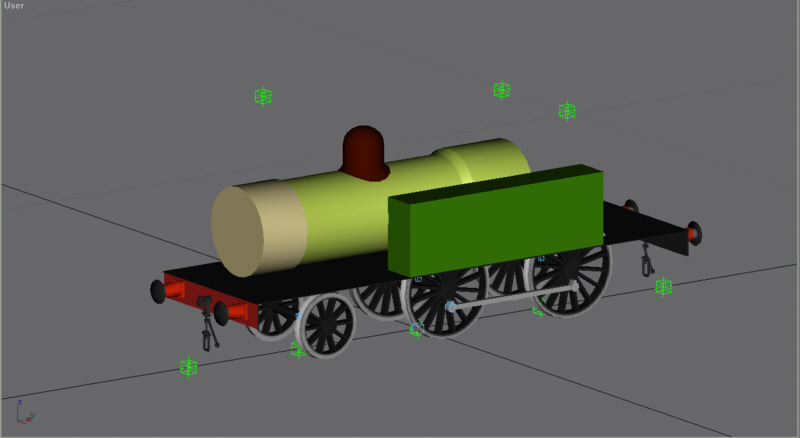
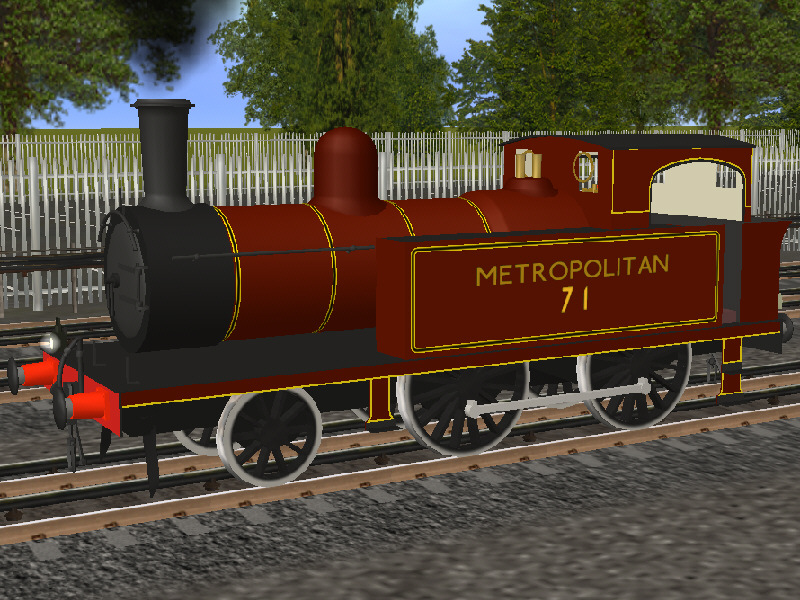
| Item |
KUID |
Status |
|---|---|---|
| Metropolitan D Class loco |
<KUID2:338848:210:1> |
In Progress/Alpha |
| D class front bogie |
<KUID2:338848:50035:1> |
In Progress/Alpha |
| D class rear bogie |
<KUID2:338848:50036:1> |
In Progress/Alpha |
| Head lamp |
<KUID2:338848:35005:1> |
Published on TPR |
| Tail lamp |
<KUID2:338848:35002:1> |
Published on TPR |
My first steam locomotive for the London Underground is a
Metropolitan Railway E class locomotive, 7 of which were built between
1986 and 1901. The first 3 were built by Neasden Works and numbered
77-79. On entry into service, number 79 was renumbered 1 replacing an
accident damaged A class locomotive. The remaing four locos were built
by Hawthorn-Leslie and numbered 79-82. Most were originally fitted with
condensing apparatus,
so could run in the cut & cover sections as well as in the open.
Originally they operated passenger services out to Aylesbury, but from
1937 they were confined to engineering and ballast workings. Four
of the locos were retained by London Transport, who renumbered them as
L44-L48. They were
withdrawn in 1962 after being replaced by the red panniers, but
thankfully
Locomotive L44 (originally no. 79, later no. 1) is preserved at the
Buckinghamshire Railway Centre at Quainton Road.
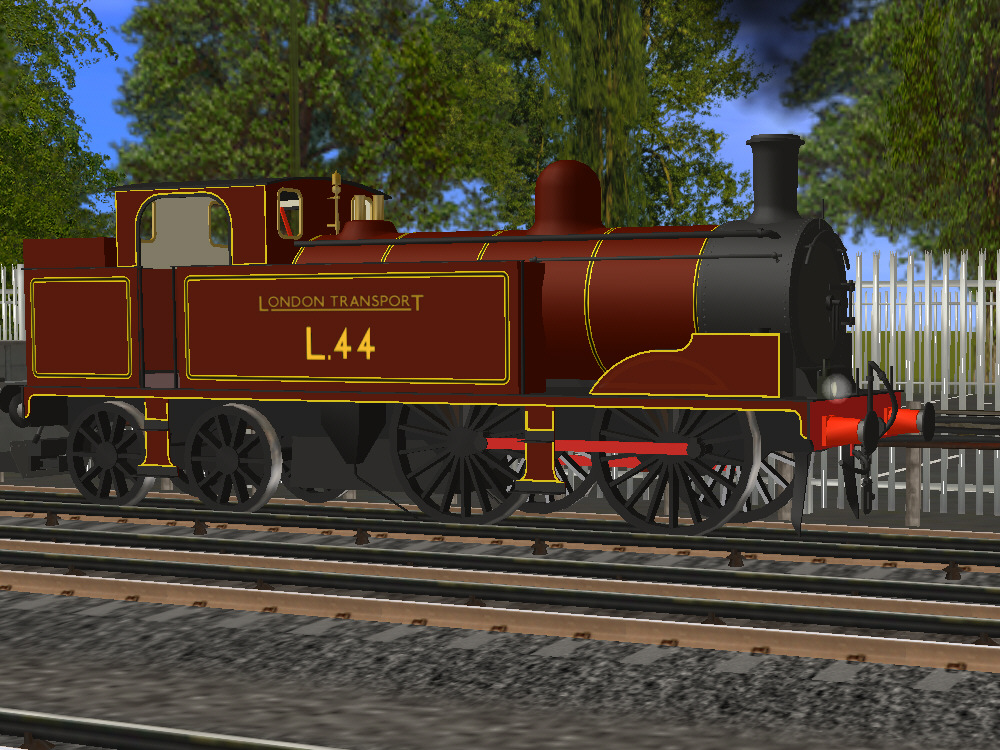
| Item |
KUID |
Status |
|---|---|---|
| ex-Metropolitan E Class non-condensing loco in LU livery |
<KUID2:338848:190:1> |
Published on TPR |
| Metropolitan E Class non-condensing loco in Metropolitan livery |
<KUID2:338848:191:1> |
In Progress |
| Metropolitan E Class condensing loco in Metropolitan livery |
<KUID2:338848:192:1 |
In Progress |
| ex-Met E class front bogie |
<KUID2:338848:50025:1> |
Published on TPR |
| ex-Met E class rear bogie |
<KUID2:338848:50026:1> |
Published on TPR |
| Metropolitan E class front bogie |
<KUID2:338848:50029:1> |
In Progress |
| Metropolitan E class rear bogie |
<KUID2:338848:50030:1> |
In Progress |
| Head lamp |
<KUID2:338848:35005:1> |
Published on TPR |
| Tail lamp |
<KUID2:338848:35002:1> |
Published on TPR |
The Metropolitan Railway F class consisted of four locomotives, built in 1901 by the Yorkshire Engine Company for freight use on the main line. Originally numbered 90-93, they were all retained by London Transport, who renumbered them as L49-L52. Three of the class were withdrawn in 1957/58, but L52 lasted until 1962. It would have been preserved, but was found to have cracked mainframes, so E class L44 was purchased instead.
I was unable to locate a drawing of the F class, but as can be seen
from the picture of an E class body on the F class chassis arrangement,
the F class is considerably larger, and the body will require stretching to fit.
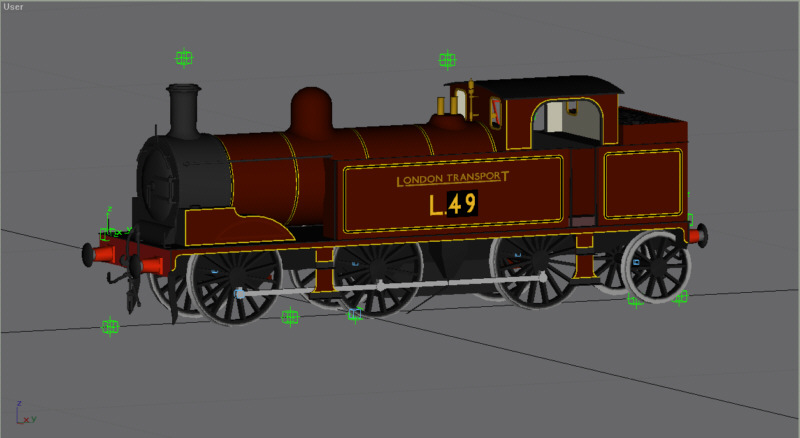
| Item |
KUID |
Status |
|---|---|---|
| Metropolitan F Class loco in LU livery |
<KUID2:338848:200:1> |
In Progress |
| Metropolitan F Class loco in Met livery |
<KUID2:338848:201:1> |
Planned |
| LU ex-Met F class front bogie |
<KUID2:338848:50031:1> |
Complete |
| LU ex-Met F class rear bogie |
<KUID2:338848:50032:1> |
Complete |
| Metropolitan F class front bogie |
<KUID2:338848:50033:1> |
In Progress |
| Metropolitan F class rear bogie |
<KUID2:338848:50034:1> |
In Progress |
| Head lamp |
<KUID2:338848:35005:1> |
Published on TPR |
| Tail lamp |
<KUID2:338848:35002:1> |
Published on TPR |
A Class of four 0-6-4Ts built in 1915 by the Yorkshire Engine
Company. They were numbered 94-97, and originally all carried names
(Lord Aberconway, Robert H Selbie, Charles Jones and Brill). They were
transfered to the LNER in 1937.
A class of eight 4-4-4Ts built in 1920, by Kerr Stuart & Co.,
numbered 103-110. They were used for express work between Harrow and
Aylesbury, or Verney Junction. They were transfered to the LNER in 1937.
A class of six 2-6-4Ts built in 1924 by Armstrong Whitworth, and numbered 111-116. They incorporated parts of Maunsell SECR 2-6-0s built at Woolwich for war purposes, which were surplus at the end of hostilities. They were intended for freight purposes, mainly coal from Verney Junction to Neasden power station. They were transfered to the LNER in 1937.
By the 1950s, the ex-Metropolitan Railway steam engines used by London Transport were in need of replacement, and after trials of several locomotives, they decided to purchase several GWR 5700 class pannier tank locomotives. A total of eleven locomotives were purchased beginning in 1956, and numbered L89-L99. Two of these were later replaced by the purchase of further locomotives when they were found to need extensive repairs. The last locomotive was withdrawn in 1971, and six have been preserved.
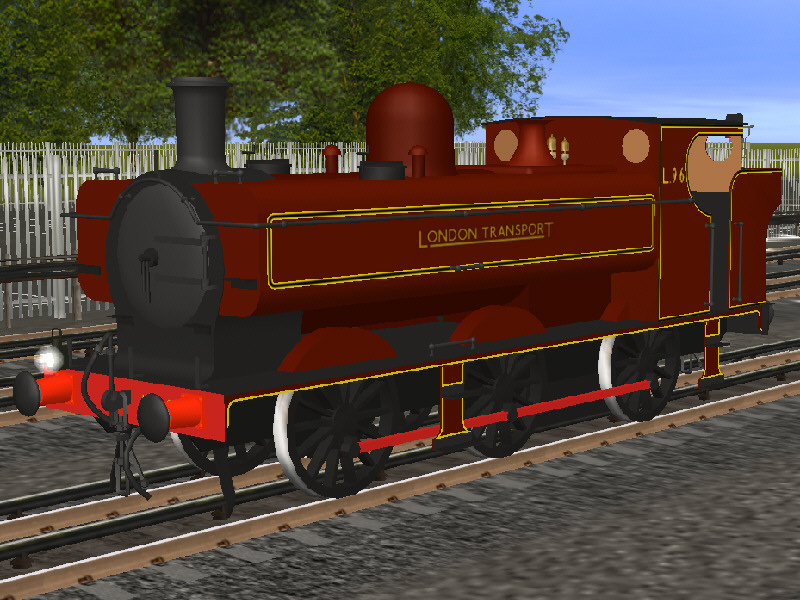
| Item |
KUID |
Status |
|---|---|---|
| London Underground ex-GWR Pannier Tank |
<KUID2:338848:230:1> |
Alpha
|
| LU ex-GWR 5700 class bogie |
<KUID2:338848:50043:1> |
Beta |
| Head lamp |
<KUID2:338848:35005:1> |
Published on TPR |
| Tail lamp |
<KUID2:338848:35002:1> |
Published on TPR |
The largest number of open/flat wagons on the London Underground
were these 30 ton capacity 50ft bogie vehicles first ordered in 1931,
and supplied by several different contractors. Often refered to as GP
(General Purpose) wagons, a term which strictly only applies to the
later Procor built wagons. They could be used as open wagons for
ballast, or by removing the sides, could be used as flat wagons for
rails or sleepers. Originally fitted with Ward couplers and swing back
buffers, some were refurbished in the early 1980s and were then fitted
with retractable buffers and buck-eye couplers
| Number |
Builder |
Year |
| F310-315 |
Metropolitan-Cammell | 1931 |
| F316-325 |
Gloucester |
1935 |
| F331-340 | Gloucester |
1937 |
| F341-371 |
Gloucester | 1951 |
| F372-375 |
Gloucester | 1956 |
| F376-377 | Acton Works | 1959 |
| F378-383 | Gloucester |
1959 |
| F384-391 | BR Ashford |
1965 |
| F392-398 | BR Ashford | 1966 |
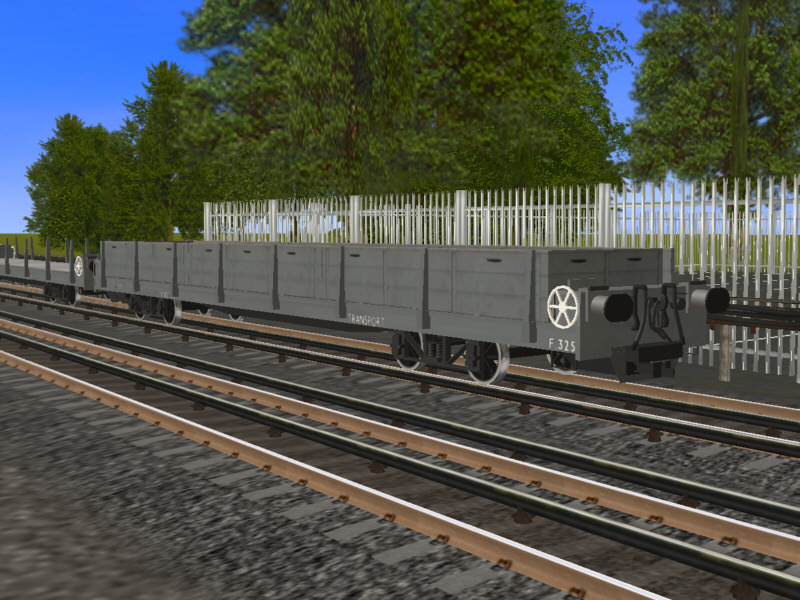
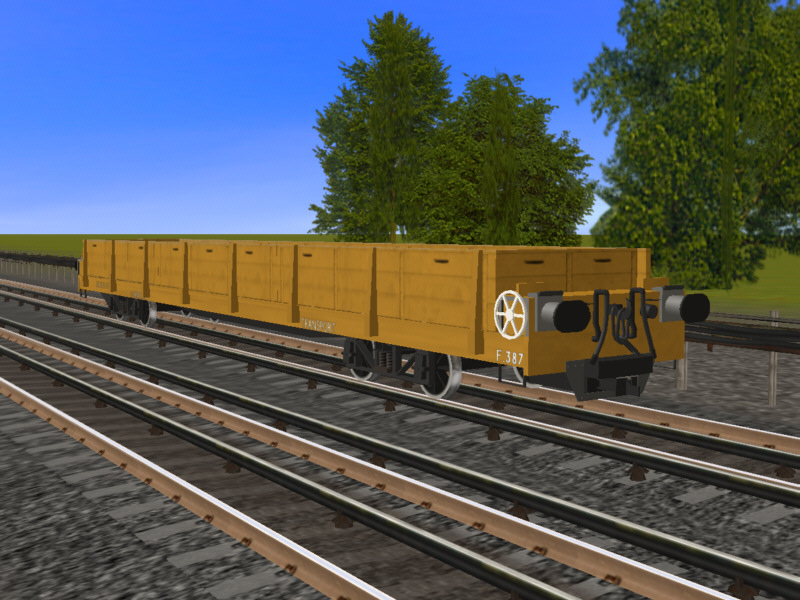
| Item |
KUID |
Status |
|---|---|---|
| Ex-BR Brakevan |
<KUID2:338848:15010:1> |
In Progress / Alpha |
| Ex-Metropolitan Brakevan |
<KUID2:338848:15011:1> |
In Progress |
| 50ft Bogie Flat Wagon (grey livery) | <KUID2:338848:15012:2> | Published on TPR |
| 50ft Bogie Flat Wagon (grey livery) |
<KUID2:338848:15012:1> |
Published on TPR |
| 50ft Bogie Flat Wagon (yellow livery) | <KUID2:338848:15013:2> | Published on TPR |
| 50ft Bogie Flat Wagon (yellow livery) |
<KUID2:338848:15013:1> |
Published on TPR |
| Diamond Frame Bogie | <KUID2:338848:50024:2> | Published on TPR |
| Diamond Frame Bogie |
<KUID2:338848:50024:1> |
Published on TPR |
Page updated : 01 Jan 2016